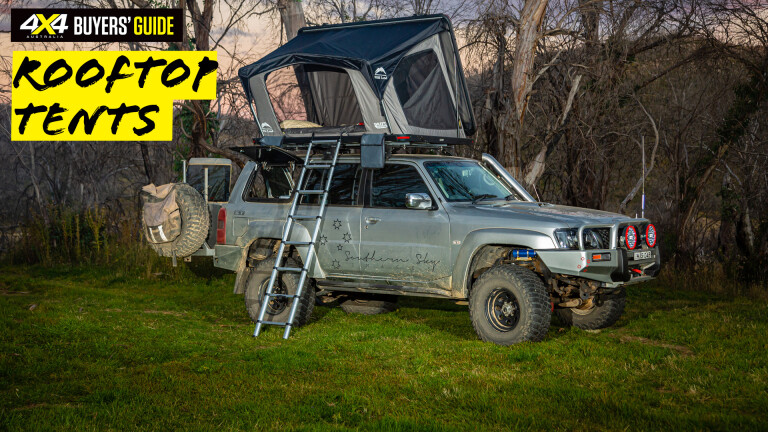
We're sure most of us have either done it or seen someone do it. Buy a $20 tent and an airbed to head off camping for the weekend. It rarely ends well and invariably one or both leak and you end up wet and/or on the ground. The result of this experience is typically an upgrade to either a swag or a touring tent. Both have their advantages.
So, what combines the ease of set up and pack down that comes with a swag plus the space and protection of a tent? What could this mythical camp set-up be? Of course, we’re talking about rooftop tents. They really do provide the best of both worlds.
Spend some time in croc country and want that little bit of extra security of not sleeping on the ground or camping in hot weather where a bit of cross-breeze might be nice? A rooftop tent has you covered.
The technology of rooftop tents has come a long way in recent years. Sure, there’s still the basic canvas, fold-out set-ups available (and gee, they have come down in price), but now there’s all kinds of variations of hard-shell tents. From straight pop-tops to clamshells, setting up and packing up a has never been quicker or easier.
Perhaps the first thing we should do here is describe the various types of tents available so you don’t get confused and think I’m talking about tacos. First, the soft-shell variety. These typically consist of a small, hard base that the canvas tent is mounted to. The tent usually features a frame of poles and folds out to double the floor size of its mounted footprint. These types are the cheapest available and are typically lighter than hard-shell varieties.
Hard-shell tents usually consist of a metal case with a top and bottom half that are linked together with canvas walls. The original generation typically included the entire top half lifting evenly to create essentially a box with a metal roof and floor and canvas walls. The newer generation are called ‘clamshell’ and are hinged at one end so the roof raises from one side only.
The biggest difference between the two varieties is time. Setting up a soft-shell rooftop tent is around a 5-minute proposition vs around 1 minute for a hard-shell tent. Pack-up times have a similar difference in around 10 minutes for a soft-shell vs around 2 minutes for a hard-shell.
Product details
Soft-shell rooftop tents require around half the roof footprint of their hard-shell alternatives. There’s no doubt hard-shell tents are quicker and easier to set up and pack up.
One of the biggest differences between hard- and soft-shell rooftop tents is the cost. So, for that reason, we have split this comparison into two categories:
- Hard-shell rooftop tents
- Soft-shell rooftop tents
Hard-shell Rooftop Tents
| James Baroud Evasion Evolution | Campboss RTT Boss Tent | Darche Ridgeback | Drifta Stockton 1.2 | Bush Company AX27 | Motop MT-135 V5 | |
|---|---|---|---|---|---|---|
| Sleeping Area | 200cm (L) x 140 (W) x 100cm (H) | 240cm (L) x 140cm (W) x 125cm (H) | 200cm (L) x 130cm (W) x 144cm (H) | 205cm (L) x 120cm (W) x 125cm (H) | 213cm (L) x 128cm (W) x 170cm (H) |
217cm (L) x 120cm (W) x 145cm (H) |
| Folded Size | 204cm (L) x 143cm (W) x 33cm (H) | 233cm (L) x 148cm (W) x 22cm (H) | 216cm (L) x 136cm (W) x 21.5cm (H) | 220cm (L) x 130cm (W) x 16cm (H) | 225cm (L) x 140cm (W) x 17.5cm (H) |
225cm (L) x 143cm (W) x 16cm (H) |
| Weight | 65kg | 83kg | 85kg | 56kg | 99kg | 75kg |
| Mattress | 65mm foam | 60mm foam | 55mm foam | 70mm foam | 80mm double layer foam | 60mm self-inflating |
| Warranty | 5 years | - | 3 years | 2 years | 2 years | 1 year |
James Baroud Evasion Evolution RTT
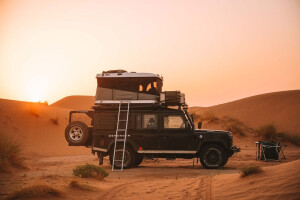
Specifications
- Sleeping Area: 200cm (L) x 140 (W) x 100cm (H)
- Folded Size: 204cm (L) x 143cm (W) x 33cm (H)
- Weight: 65kg
- Mattress: 65mm foam
- Warranty: 5 years
Things we like
|
Not so much
|
The beauty of James Baroud’s Evasion Evolution rooftop tent is that once you pull the handbrake at a campsite for the night, you can be set-up in seconds. All the user has to do is release the catches, and gas struts automatically raise the upper hull to expand the tent space.
Pack-down is just as easy, as elasticised seams draw the fabric sides into the hull when the upper hull is lowered by hand.
The hard-shell tent is waterproof and wind-tested to 120km/h, and its compact size when set-up means it’ll have minimal impact when touring on-road. The upper and lower hulls feature three layers of reinforced fibreglass with a sleek gelcoat finish. Two built-in aluminium rails and six mounting brackets are included, so it can be easily attached to roof racks.
Once set-up, all openings and doors are completely screened against insects, and a 65mm high-density foam mattress is provided for cosy siestas. A folding ladder with telescopic legs makes entry and exit an easy affair, and a ventilation fan, silent and automatic in its operation, keeps the air fresh.
The canvas is a patented James Baroud design, which encompasses six spray layers of aluminium-impregnated canvas that is heat-reflective and insulating, as well as waterproof.
The fabric used is a high-quality double-stitched aluminised polyester, while a tear-resistant mesh keeps mozzies at bay. The clever design provides 360-degree views.
Campboss RTT Boss Tent
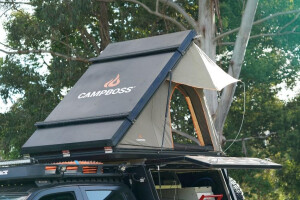
Specifications
- Sleeping Area: 240cm (L) x 140cm (W) x 125cm (H)
- Folded Size: 233cm (L) x 148cm (W) x 22cm (H)
- Weight: 83kg
- Mattress: 60mm foam
Things we like
|
Not so much
|
One of the big issues with metal shelled rooftops tents is condensation. Cold metal and hot-water vapour in the form of your breath = condensation. Campboss has tackled this with a 20mm anti-condensation mat under the mattress and a carpet lined roof. So that will help keep things dry on the inside and 280gsm polycotton Ripstop canvas should stop water from the outside getting in.
This tent is ideal for lifted vehicles with a 2.6m-long ladder. The shell is aluminium to keep weight down and has been constructed in sections to allow replacement of sections in the event they are damaged. It’s got clever inclusions like USB charging outlets, LED strip lights and a clear pocket hanging from the roof for a tablet/iPad for those rainy-day movies.
The awning fly extends around the sides and front to allow open windows even when it rains. The tent is thick when closed, but this does mean you can leave your bedding in when closing.
Darche Ridgeback
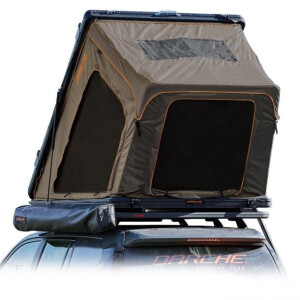
Specifications
- Sleeping Area: 200cm (L) x 130cm (W) x 144cm (H)
- Folded Size: 216cm (L) x 136cm (W) x 21.5cm (H)
- Weight: 85kg
- Mattress: 55mm foam
- Warranty: 3 years
Things we like
|
Not so much
|
This one is all about the windows. The Darche Ridgeback has taken some cues from the Panorama range and includes massive side and rear windows plus a rooftop window.
The design is a little different to others in this category. Rather than a straight section of canvas joining the top and bottom of the tent at the rear, with an awning over the entry, this tent makes that awning space into internal space. This means sitting up inside is a lot more user friendly, as that rear wall slopes outwards rather than inwards and as a result, the inside of the tent will feel bigger.
The result of this design is no fly cover over windows meaning they need to stay closed in rain. To help condensation in this scenario, Darche has included a 10mm anti-condensation mat. The unique Ridgeback design of the shell is claimed to be more aerodynamic than competitors, which is super handy given that diesel is now priced per kidney rather than in dollars.
Drifta Stockton 1.2
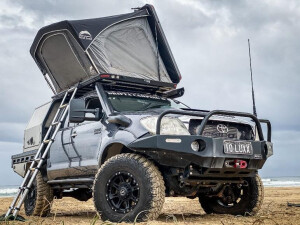
Specifications
- Sleeping Area: 205cm (L) x 120cm (W) x 125cm (H)
- Folded Size: 220cm (L) x 130cm (W) x 16cm (H)
- Weight: 56kg
- Mattress: 70mm foam
- Warranty: 2 years
Things we like
|
Not so much
|
One for those who prefer side entry. This tent is hinged along the edge rather than the short edge, meaning it’s the only one set-up for side entry as a priority. This tent comes with handy inclusions like roof racks, LED lighting and USB points inside the tent.
At 56kg, it’s far and away the lightest tent in this class. Drifta achieves this by having a floor that consists of rails rather than a solid floor. It might seem a little unusual at first but does work well with the supplied ‘solid base’ mattress.
At only 16cm thick, this is also the thinnest tent in this class. Fantastic news for aerodynamics and the suffering hip pocket. The downside is that all bedding needs to be removed to close the tent.
The tent comes with included roof racks and an internal LED light. The fly design allows airflow for those warmer nights and also means the main portion of canvas stays dry in a wet pack up.
The Bush Company AX27
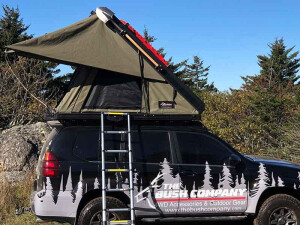
Specifications
- Sleeping Area: 213cm (L) x 128cm (W) x 170cm (H)
- Folded Size: 225cm (L) x 140cm (W) x 17.5cm (H)
- Weight: 99kg
- Mattress: 80mm double layer foam
- Warranty: 2 years
Things we like
|
Not so much
|
Straight out of the land where rooftop tents were originated: South Africa. The biggest and best awning in this class provides excellent coverage over both side and the rear window/entry. This is a premium rooftop tent and is priced accordingly. With the biggest open height in class at 1.7m, the smaller humans among us would be able to stand in this tent, which is a very rare capability for a hard-shell rooftop tent.
The tent comes prewired with a 50amp Anderson plug that when plugged into your vehicle provides USB and cigarette outlets plus LED lighting. The mattress is 80mm thick and includes two layers of foam: a high density layer, and a softer, comfort layer.
Another with a 2.6m ladder, meaning it’s well-suited to lifted vehicles. If cold climates are where you spend your camping, the dual-layer 310 polyester Ripstop acrylic infused mould and mildew resistant canvas should provide plenty of insulation and the steep angle of the roof/shell when open means it’s well suited to snow.
Motop MT-135 V5
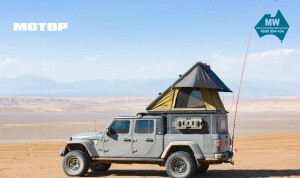
Specifications
- Sleeping Area: 217cm (L) x 120cm (W) x 145cm (H)
- Folded Size: 225cm (L) x 143cm (W) x 16cm (H)
- Weight: 75kg
- Mattress: 60mm self-inflating
- Warranty: 1 year
Things we like
|
Not so much
|
This rooftop tent sits in the middle of the class in terms of price but does offer a few high-end features. The tent features a three-sided fly that covers all three windows and entry doors, and includes internal power for USB charging and lighting.
The first few generations of the Motop tents came with a bunch of issues, including condensation and leaks, but it appears Motop has listened to its customers and gradually improved the design with each update. Now at version 5, these issues are all but gone with revised tent-to-shell connections, new anti-condensation mat and roof lining/insulation.
This tent comes in a slimline version and a ‘plus’ version. The slimline version is one of the thinnest in this class at only 16cm, with the obvious aerodynamic advantage and the disadvantage of limited space for bedding. Motop has addressed this too, by providing a self-inflating mattress standard with the tent that both provides extra comfort over foam and allows some bedding to be stored in the tent when the mattress is deflated.
Soft-shell Rooftop Tents
| OZtrail Tarkine 1400 | Darche Panorama | Front Runner | 23Zero Dakota 2200 | |
|---|---|---|---|---|
| Sleeping Area | 240cm (L) x 143cm (W) x 130cm (H) | 240cm (L) x 140cm (W) x 125cm (H) | 243.8cm (L) x 129.5cm (W) x 116.8cm (H) | 240cm (L) x 220cm (W) x 120cm (H) |
| Folded Size | 143cm (L) x 123 (W) x 31 (H) | 121.5cm (L) x 143.5 (W) x 29 (H) | 133.3cm (L) x 124.5cm (W) x 33cm (H) | 125cm (L) x 225cm (W) x 33cm (H) |
| Weight | 68kg | 63.6kg | 43kg | 87kg |
| Mattress | 60mm foam | 50mm foam | 60mm foam | 65mm foam |
| Warranty | 1 year | 3 years | 2 years | 2 years |
OZtrail Tarkine 1400
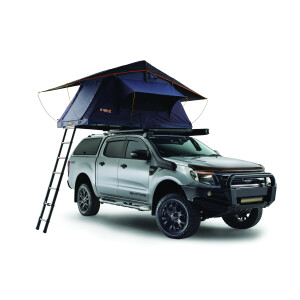
Specifications
- Sleeping Area: 240cm (L) x 143cm (W) x 130cm (H)
- Folded Size: 143cm (L) x 123cm (W) x 31cm (H)
- Weight: 68kg
- Mattress: 60mm foam
- Warranty: 1 year
Things we like
|
Not so much
|
The Tarkine is the entry-level rooftop tent in the OZtrail Overlander range, and the only one made in a pure soft-shell construction. It is lightweight and its size means it’s suitable for smaller 4x4s and SUVs. It weighs 59kg when set-up (inc. ladder) and measures 2.4m x 1.43m x 1.3m when open (1.43m x 1.23m x 0.31m when closed).
A comfortable 60mm high-density foam mattress is included, and it utilises a 280gsm Ripstop polycotton canvas and 210D polyoxford flysheet, so it'll protect occupants from both heat and rain. It also includes an LED lighting strip and a SkyMesh roof panel to enable campers to gaze at the stars while they drift off to sleep.
Darche Panorama
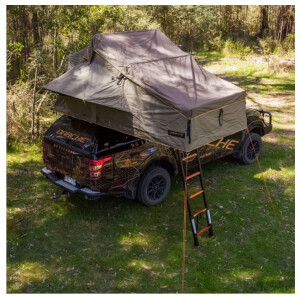
Specifications
- Sleeping Area: 240cm (L) x 140cm (W) x 125cm (H)
- Folded Size: 121.5cm (L) x 143.5 (W) x 29 (H)
- Weight: 63.6kg
- Mattress: 50mm foam
- Warranty: 3 years
Things we like
|
Not so much
|
Boasting premium 320gsm Ripstop polycotton canvas, seam sealing and a removable polyester fly, the Darche Panorama is ready for just about any conditions. The fly provides window covers to allow that all-important airflow, even in rainy conditions. But if clear skies are around, rip off that fly and enjoy starry-night views from the zippered sky window.
One of the biggest negatives about soft-shell tents is a wet pack up. Folding all that wet canvas straight on to your bed means that the next night is likely to be less than pleasant. This is where another huge advantage of that 210D Ripstop polyester fly comes in. Whip off the wet fly in the morning and pack up a relatively dry tent.
Front Runner
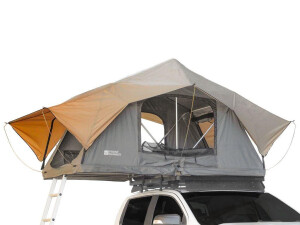
Specifications
- Sleeping Area: 243.8cm (L) x 129.5cm (W) x 116.8cm (H)
- Folded Size: 133.3cm (L) x 124.5cm (W) x 33cm (H)
- Weight: 43kg
- Mattress: 60mm foam
- Warranty: 2 years
Things we like
|
Not so much
|
One of the smaller and definitely lightest tent in this class, coming in at only 43kg, this is the tent for those with limited roof-rating capacity – calling all zuke owners. The main tent is constructed of 260g polycotton Ripstop canvas and the fly is 400d polyester Oxford fabric. The fly doesn’t cover the entire tent but does provide good roof coverage and small awnings over windows and doors.
Purchase the optional quick-release mounting kit and this tent is ideal for those that remove the tent during the week and put it back on for the weekend. If you want to leave the tent on full-time, then don’t be too worried about wind drag because at 33cm thick, it’s one of the thinner tents in this class. The downside of this is you will need to remove bedding to pack it up.
23Zero Dakota 1400

Specifications
- Sleeping Area: 240cm (L) x 220cm (W) x 120cm (H)
- Folded Size: 125cm (L) x 225 (W) x 33cm (H)
- Weight: 87kg
- Mattress: 65mm foam
- Warranty: 2 years
Things we like
|
Not so much
|
The big difference with this rooftop tent is that it’s, well, big. At 2200mm wide there’s almost an extra metre of space compared to competitors in this class. More than this, the tent has two ladders and can be split with an internal wall.
If you have a young family and thought that rooftop tents were for couples only, the 23Zero is here to enlighten you. This tent is rated to sleep 5, but realistically 2 adults and 2 small kids is feasible. As a result of its size, this tent is heavy (87kg), so will only suit certain vehicles and set-ups.
With features including Light Suppression Technology (LST), 280gsm polycotton and a 210d polyester fly, this tent is ready to keep everything out. The LST is a dark coating on the inner walls of the tent to keep it darker in the mornings and cooler on warm days.
The frame has 25mm aluminium poles that pivot on a stainless-steel yoke. 23Zero claims its tents do not need seasoning due to the pre-shrunk canvas and seam sealing.
How we review products
4X4 Australia has been reviewing four-wheel drive vehicles and aftermarket products for more than 40 years.
When looking for the best rooftop tents in Australia, we considered value for money, that all-important weight, speed of set up and pack up, and functionality/features. We compared features across hundreds of products split in to two categories: soft-shell tents, and hard-shell tents.
In addition to this, we also looked at thousands of user reviews and our own experience with these products to make sure our recommendations are for the best on the market.
We’ve also included a few pointers on what to look for when purchasing a rooftop tent and how to avoid being ripped off or disappointed.
Disclosure: When you buy through our links, we may earn a commission. We also include products that we do not earn a commission from.
Buyers’ Guide to Rooftop Tents
Rooftop tents were originally conceptualised for areas where sleeping on the ground is scary and downright dangerous. I love a swag as much as anyone, but sleeping in a canvas bag on the ground in lion country would make me feel like the meat in a sausage roll. Tents are better for this but still have the issue of being on the ground. So, what if we put the tent on top of the vehicle? Nice idea but pretty difficult to peg down right. So, instead, let’s design a tent that is specifically designed to be bolted on to a roof.
The early generations of rooftop tents were pretty basic, but in the last 20 years or so, the design and technology has come along in leaps and bounds. Soft-shell tents are the older of the currently available designs and still work really well.
Set up takes around 5 minutes and pack up usually around 10 minutes. That’s pretty good for a tent but it’s not going to compete with a swag or a fast touring tent. This is where hard-shell tents came in. Originally, these were designed with a top and bottom joined by canvas and the top simply lifted to create a flat roof. This design has been mostly phased out these days in favour of clamshell tents. These are hard-shell tents with a top and bottom that is hinged along one edge, meaning rather than the entire roof lifting up, only one side lifts to create a triangle tent.
These clamshell tents are a genuine competitor with the humble swag in terms of set up and pack up times. In fact, they’re probably even quicker than the fancy swags with poles that are on offer these days.
Value for money
A rooftop tent can cost from similar to a touring tent all the way up to camper trailer money. Entry-level tents are typically more cumbersome and slower to set up and pack up. Higher-end tents include internal power, quality build and awnings that allow open windows in rain.
Value for money really comes down to how you will use your rooftop tent. If you’re going to spend 6 months a year living on the road and sleeping in a rooftop tent, then we would thoroughly recommend splurging on a top-of-the-range tent and even then, probably upgrading the mattress. But if you’re only camping a week at Christmas and a long weekend at Easter, you’re probably going to want something a little more economical.
Beware the cheap price though. Not all rooftop tents are equal and you really do get what you pay for. There are cheap no-name options out there and they may well work, but in the same way a $20 festival tent will give you somewhere to sleep for a night. You wouldn’t take that same tent on a trip through the Simpson Desert and expect it to do the job.
A well-known and respected brand with a solid warranty and after-sales support should be highly valued when considering your purchase.
Weight
Vehicle roof load limits and roof rack load limits vary wildly from manufacturer to manufacturer, and even between models. It’s so important to keep within those limits. Failure to do so not only results in broken racks and ruined trips, but it can also be downright dangerous. In our remote area travels, we've come across plenty of vehicles on their sides with a big, heavy rooftop tent still attached to the roof. For this reason, knowing these limits and purchasing a tent that fits within those limits is vital.
Your average dual-cab ute will have a roof load rating of around 80kg. Add a roof rack that weighs say 10kg and you’ve only got 70kg capacity left. Add a 65kg rooftop tent and some bedding and you’re maxed out. A full sized wagon might have a roof load rating of around 100kg.
The soft-shell options in this buyers’ guide vary from 43kg to 87kg meaning the heavier options won’t suit a dual-cab ute but the remainder of soft-shell options will suit most mounting methods on most vehicles. The hard-shell options vary from 56kg to 99kg. The only realistic option for the heavier tents in this category is tray mounting of some type, such as heavy-duty ladder racks or heavy-duty canopies.
Weight not only dictates the type of tent that will suit your set-up, but also which specific tent would best suit your vehicle.
Speed of set up and pack up
Most soft-shell tents can be set up within around 5 minutes. It’s basically a case of remove the cover, fold out the tent, erect any internal poles and peg down your guide ropes. Pack up takes a little longer, mostly due to trying to squeeze all the canvas back between the base and top plates, and get the cover on and zipped up. You will often see people packing up a soft-shell tent climbing all over the roof to reach that zipper.
A hard-shell rooftop tent can be set up in as little as 90 seconds and generally packed up in a few minutes. With the clamshell design, it’s typically release a couple of latches, push the roof up and erect any fly poles or internal poles.
Now every camp set-up takes time so is the hard-shell’s increase in speed worth it for the extra money? Well speaking from personal experience, we can say 100 per cent yes. With our photographers, their nights often go something like this. Go chasing a sunset, roll into camp at around 7 to 8pm, pop the tent and have a few hours sleep; wake up and pack up to go chasing a Milky Way image; back to bed around 2am (pop the tent again) before packing up at 4am to go chase a sunrise. On a night like that, the difference between 90 seconds to 5 minutes to set up is, well ... night and day.
Now understand we are a fair way out there and the average punter isn’t going to set up and pack up 3 times in a night, but if you’re doing it every day on a long trip that extra speed becomes so valuable.
Functionality/Features
Now in dry weather a rooftop tent is basically a way to carry a mattress around easily. That’s a pretty basic function. But when the weather turns and the tent becomes your only shelter, you’re going to love features like awnings that allow open windows, USB charging, clear pockets to hang your iPad/tablet and watch a movie.
As you could imagine, the cheaper soft-shell tents often lack a lot of premium features, as do the lower-end hard-shell tents (did we say you get what you pay for yet?). Again, you need to have a think about what you will be using the tent for here. Only ever camp on weekend boys’ trips? You’re probably not going to find yourself watching an iPad in the tent. Doing the big lap? The ability to escape to a movie on the iPad is likely to be highly valued.
How to avoid being ripped off
As mentioned previously, there’s plenty of no-name options out there that might seem like good value until something goes wrong and you can’t get parts and after-sales support is just a pipedream. Cheap fixings, mounts and canvas will ruin a trip when things go wrong. A leaky tent or one that won’t close properly will quickly get frustrating.
Look to reputable manufacturers with a good warranty to avoid these issues. Be sure to check the warranty fine print before pressing go on a purchase, as some manufacturers will cover the frame for a period and the canvas for a different period.

COMMENTS